Beyond Energy Access: How Renewable Energy Fosters Resilience in Island Communities
Abstract
1. Introduction
- (i)
- Persistence, or coping capacity, refers to the ability of resilient systems to cope with shocks and to restore well-being to current levels after the events.
- (ii)
- Adaptation, or adaptive, capacities are preventive actions that individuals or communities employ to learn from experience or to reduce the impact of predicted shocks. The skills and resources required for adaptation are different than those required for coping and may require mobilizing additional outside resources or knowledge. For instance, ref. [15] reports that, to promote adaptive capacity, the community needs to engage in economic development, bolster social, political, and cultural capital, and improve information and communication capabilities.
- (iii)
- Transformative capacities refer to people’s abilities to change the larger structures and systems in which they live, implying adaptation at larger scales and thus a more radical shift.
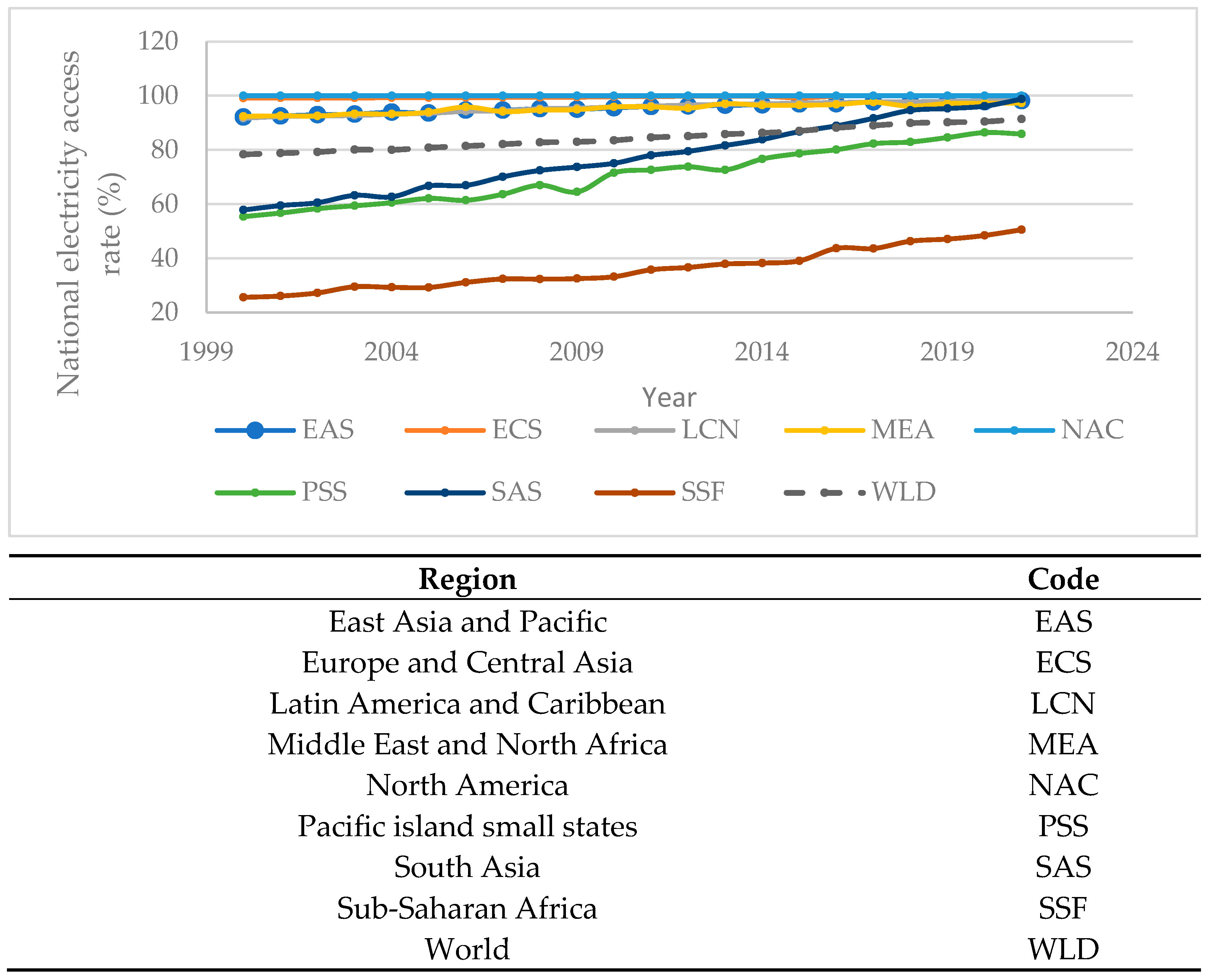
1.1. Making a Case for Resilience Study in Fiji’s Context
- (i)
- Tropical Cyclones:
- (ii)
- Floods and Droughts:
- (i)
- Extreme Temperatures:
- (ii)
- Sea Level Rise:
- (i)
- High Fuel and Food Prices:
- (ii)
- Health Crisis:
1.2. Study Objectives
- (i)
- Identify and evaluate the various ways CESs strengthen community assets (including human, social, cultural, financial, natural, built, and political) across three distinct case studies in Fiji using a combination of qualitative and quantitative methods;
- (ii)
- Assess how these strengthened assets enhance communities’ absorptive, adaptive, and transformative capacities in response to climate change impacts and other shocks; and
- (iii)
- Develop evidence-based recommendations for policymakers and practitioners to promote and implement CESs as a means to build community resilience in Fiji and other SIDSs based on insights from the case studies.
1.3. Innovation and Contribution
- (i)
- Expanding the Scope:
- (ii)
- Applying a Resilience Framework:
- (iii)
- Providing Policy Recommendations:
2. Literature Review
2.1. Terminology of Community Resilience and Frameworks
2.2. Studies on Community Resilience from the RE Initiative
2.3. Enhancing Community Resilience Through RE Initiatives in the Pacific
3. Materials and Methods
3.1. Qualitative Method
- (i)
- Data Collection Instruments
- Demographics: Age, gender, occupation, education level, and household size.
- Socioeconomic factors: Income, employment opportunities, and access to essential services.
- Energy context: Current energy sources, challenges, perceptions of renewable energy, and adaptive strategies employed by communities to address climate change and disasters.
- (ii)
- Site Selection
- Secondary School in Ba (Figure 3a)
- ◦
- Solar PV System: A 25 kW grid-connected solar system installed in July 2023, funded by the USD 100,000 Zayed Sustainability Prize [92].
- ◦
- Rainwater-Harvesting System: Three 3200-liter tanks were installed alongside the solar PV system to enhance water resilience.
- ◦
- Biogas Energy System: Installed in October 2020 and donated by the Fiji Water Foundation, it provides approximately one hour of cooking gas every two days.
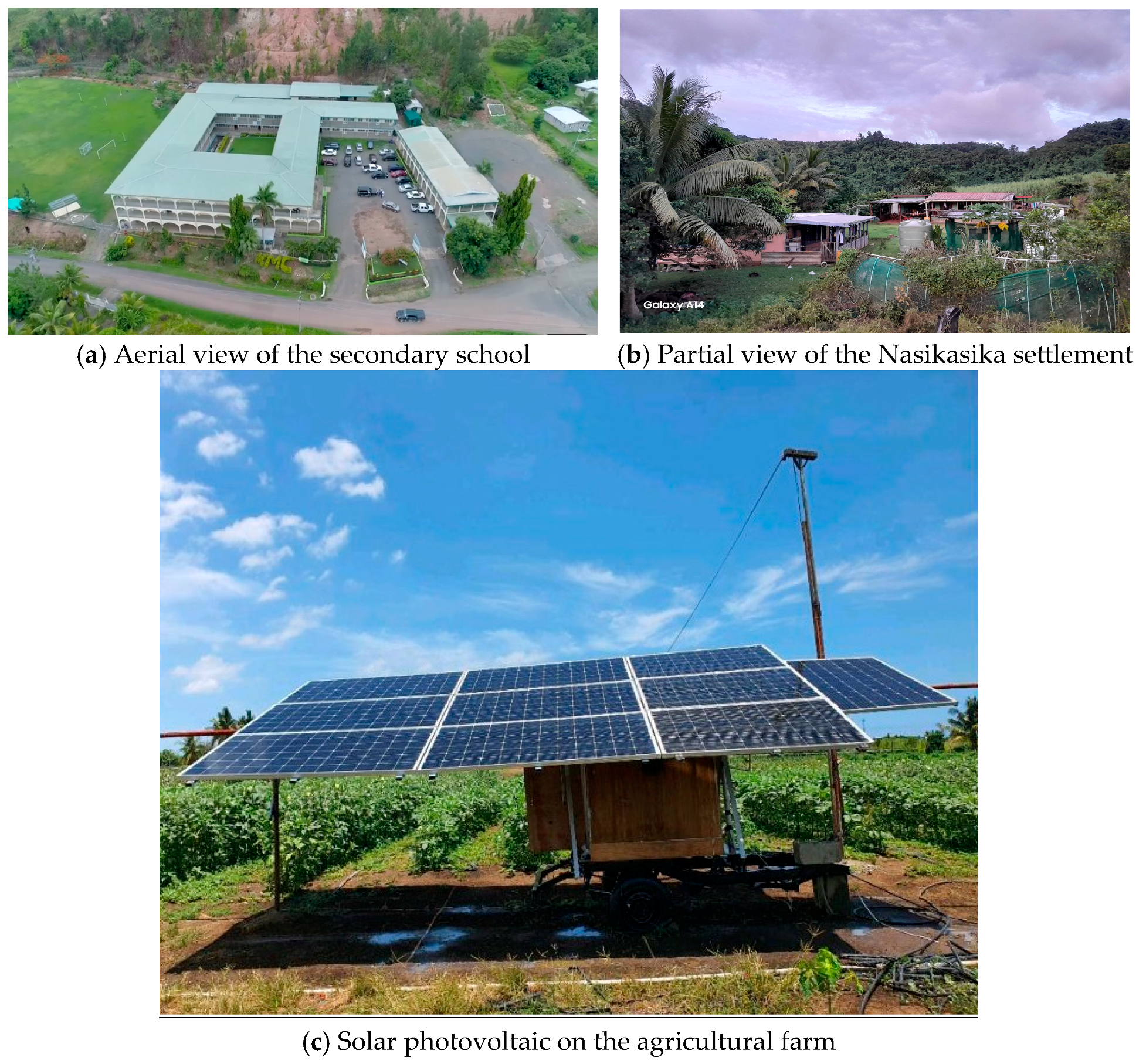

- Rural community in Nasikasika, Labasa (Figure 3b)
- Farming Household in Buabua, Lautoka (Figure 3c)
- (iii)
- Data Collection Procedures
- (iv)
- Data Analysis
3.2. Quantiative Method
4. Results
4.1. Impact of RE Systems on the School
4.1.1. RE System’s Impact on the School
4.1.2. Solar PV’s Impact on the Community
4.1.3. Solar PV’s Impact on Farm and Household
4.2. Quantitative Findings
5. Discussion
5.1. Comparison with Existing Literature
5.2. Limitations of the Study and Scope for Future Research
5.3. Policy Recommendations
- Incentivize and Support CES Adoption: Provide targeted grants, subsidies, tax breaks, or low-interest loans to encourage the adoption of renewable energy technologies, particularly in rural and remote areas. This support should be extended to households, institutions, communities, and farmers, enabling broader access to clean energy solutions.
- Conduct Public Awareness Campaigns: Launch comprehensive awareness campaigns to educate individuals and communities about available sustainable energy technologies. These campaigns should highlight the transformative potential of renewable energy to improve livelihoods, enhance resilience, and promote long-term sustainability.
- Enhance Capacity Building: Invest in robust capacity-building programs that equip community members with the necessary skills to operate and maintain renewable energy systems. By enhancing local expertise, these programs ensure the sustainability and longevity of community energy systems (CESs).
- Conduct Research and Development: Prioritize research and development initiatives focused on innovative renewable energy technologies. These efforts should be tailored to the unique needs and challenges faced by Fiji’s diverse communities and environments, fostering solutions that are locally relevant and sustainable.
- Strengthen Cross-Sector Collaboration: Promote collaboration between government agencies, non-governmental organizations (NGOs), private sector actors, and communities. This multi-stakeholder approach will enable the sharing of expertise, resources, and best practices, thus accelerating CES development and increasing the impact of renewable energy initiatives.
- Boost Meaningful Community Engagement: Implement participatory planning processes that give communities a genuine voice in the design and implementation of CES projects. Ensuring that local populations are engaged in decision making helps create solutions that are culturally appropriate and better suited to community needs.
- Promote Energy Access as a Social Equity Issue: Frame energy access as a fundamental human right and ensure that policies and programs are designed to address the needs of marginalized and disadvantaged communities. This perspective can help create inclusive strategies for increasing energy access and resilience.
6. Conclusions
Author Contributions
Funding
Data Availability Statement
Acknowledgments
Conflicts of Interest
References
- UN. Ensure Access to Affordable, Reliable, Sustainable and Modern Energy. Available online: https://www.un.org/sustainabledevelopment/energy/ (accessed on 8 May 2024).
- Riva, F.; Ahlborg, H.; Hartvigsson, E.; Pachauri, S.; Colombo, E. Electricity access and rural development: Review of complex socio-economic dynamics and causal diagrams for more appropriate energy modelling. Energy Sustain. Dev. 2018, 43, 203–223. [Google Scholar] [CrossRef]
- Haq, I.; Khan, M.; Chakma, S.; Hossain, M.I.; Sarkar, S.; Rejvi, M.R.A.; Salauddin, M.; Sarker, M.M.R. Determinants of household adoption of clean energy with its rural–urban disparities in Bangladesh. Sci. Rep. 2024, 14, 2356. [Google Scholar] [CrossRef] [PubMed]
- Sakapaji, S.C.; García Molinos, J.; Parilova, V.; Gavrilyeva, T.; Yakovleva, N. Navigating Legal and Regulatory Frameworks to Achieve the Resilience and Sustainability of Indigenous Socioecological Systems. Resources 2024, 13, 56. [Google Scholar] [CrossRef]
- Longstaff, P.H.; Armstrong, N.J.; Perrin, K.; Parker, W.M.; Hidek, M.A. Building resilient communities: A preliminary framework for assessment. Homel. Secur. Aff. 2010, 6, 1–23. [Google Scholar]
- Ahadujjaman, A.; Bak, A.; Behymer, J.; Bartsch, Z.; Bertsch, B.; Birkhimer, N.; Djafari, P.; Gion, S.; Gould, S.; Guse, J.; et al. Community Assessment of Moorhead, MN; North Dakota State University: Fargo, ND, USA, 2018; Available online: https://www.ndsu.edu/fileadmin/socanth/Community_Assessment_Reports/2018_Moorhead_Community_Assessment_2.pdf (accessed on 16 May 2024).
- Koirala, B.P.; Koliou, E.; Friege, J.; Hakvoort, R.A.; Herder, P.M. Energetic communities for community energy: A review of key issues and trends shaping integrated community energy systems. Renew. Sustain. Energy Rev. 2016, 56, 722–744. [Google Scholar] [CrossRef]
- Török, I.; Mátyus, E.; Sebestyén, T.-T.; Păunescu, C.; Havadi-Nagy, K.X. Exploring Acceptance of Agro-Biomass as Innovative Solution for Heating in Rural Areas in Romania. Resources 2024, 13, 155. [Google Scholar] [CrossRef]
- Bauwens, T.; Schraven, D.; Drewing, E.; Radtke, J.; Holstenkamp, L.; Gotchev, B.; Yildiz, Ö. Conceptualizing community in energy systems: A systematic review of 183 definitions. Renew. Sustain. Energy Rev. 2022, 156, 111999. [Google Scholar] [CrossRef]
- Serrat, O. The Sustainable Livelihoods Approach; Asian Development Bank: Mandaluyong City, Philippines, 2008; Available online: https://www.adb.org/sites/default/files/publication/27638/sustainable-livelihoods-approach.pdf (accessed on 21 February 2024).
- Ribeiro, D.; Mackres, E.; Baatz, B.; Cluett, R.; Jarrett, M.; Kelly, M.; Vaidyanathan, S. Enhancing Community Resilience Through Energy Efficiency; American Council for an Energy-Efficient Economy: Washington, DC, USA, 2015. [Google Scholar]
- Kohlitz, J.; Chong, J.; Willetts, J. Rural Drinking Water Safety under Climate Change: The Importance of Addressing Physical, Social, and Environmental Dimensions. Resources 2020, 9, 77. [Google Scholar] [CrossRef]
- Patel, S.S.; Rogers, M.B.; Amlôt, R.; Rubin, G.J. What Do We Mean by ‘Community Resilience’? A Systematic Literature Review of How It Is Defined in the Literature. PLoS Curr. 2017, 9. [Google Scholar]
- Bernier, Q.; Meinzen-Dick, R. Networks for resilience. In The Role of Social Capital; IFPRI: Washington, DC, USA, 2014. [Google Scholar]
- Cafer, A.; Green, J.; Goreham, G. A community resilience framework for community development practitioners building equity and adaptive capacity. In Community Development for Times of Crisis: Creating Caring Communities; Brennan, M.A., Phillips, R., Walzer, N., Hales, B.D., Eds.; Routledge: London, UK; Taylor & Francis: Abingdon, UK, 2022; pp. 56–74. [Google Scholar]
- WB. Access to Electricity. Available online: https://data.worldbank.org/indicator/EG.ELC.ACCS.ZS (accessed on 8 May 2024).
- Jeans, H.; Castillo, G.E.; Thomas, S. The Future Is a Choice: Absorb, Adapt, Transform-Resilience Capacities; Oxfam: Oxford, UK, 2017. [Google Scholar]
- Matarrita-Cascante, D.; Trejos, B.; Qin, H.; Joo, D.; Debner, S. Conceptualizing community resilience. In Community Development for Times of Crisis: Creating Caring Communities; Brennan, M.A., Phillips, R., Walzer, N., Hales, B.D., Eds.; Routledge: London, UK; Taylor & Francis: Abingdon, UK, 2022; pp. 34–55. [Google Scholar]
- FBoS. Fiji Statistics at a Glance. Available online: https://www.statsfiji.gov.fj/ (accessed on 19 May 2024).
- FBoS. Fiji Multiple Indicator Cluster Survey 2021, Survey Findings Report; Fiji Bureau of Statistics: Suva, Fiji, 2022.
- Kapoor, A.; Alcayna, T.; de Boer, T.; Gleason, K.; Bhandari, B.; Heinrich. Climate Change Impacts on Health and Livelihoods: Fiji Assessment; Red Cross: Geneva, Switzerland, 2021; Available online: https://www.climatecentre.org/wp-content/uploads/RCRC_IFRC-Country-assessments-FIJI.pdf (accessed on 19 May 2024).
- ADB. Summary Assessment of Damage and Needs; Asian Development Bank: Mandaluyong City, Philippines; Available online: https://www.adb.org/sites/default/files/linked-documents/50181-001-sa.pdf (accessed on 19 May 2024).
- Cargill, M.A. Addressing Water Shortages: A Catalyst for More Resilient Development in Fiji; OXFAM: London, UK, 2017; Available online: https://oxfamilibrary.openrepository.com/bitstream/10546/620335/1/rr-fiji-water-shortages-resilient-development-300817-en.pdf (accessed on 20 May 2024).
- Nisha, Z. Determining the Impact of a Flood Event: Flood Hazard Mapping and Modelling of Ba River, Fiji. Master’s Thesis, Auckland University of Technology, Auckland, New Zealand, 2023. [Google Scholar]
- Yeo, S. A review of flood resilience in Fiji. In Proceedings of the International Conference on Flood Resilience, “Experiences in Asia and Europe”, University of Exeter, Exeter, UK, 5–7 September 2013; pp. 5–7. [Google Scholar]
- Iese, V.; Kiem, A.S.; Mariner, A.; Malsale, P.; Tofaeono, T.; Kirono, D.G.C.; Round, V.; Heady, C.; Tigona, R.; Veisa, F.; et al. Historical and future drought impacts in the Pacific islands and atolls. Clim. Change 2021, 166, 19. [Google Scholar] [CrossRef]
- Igbal, M.R. The economic impact of climate change on the agricultural system in Fiji. J. Agric. Sci. 2022, 14, 144. [Google Scholar] [CrossRef]
- Shiiba, N.; Singh, P.; Charan, D.; Raj, K.; Stuart, J.; Pratap, A.; Maekawa, M. Climate change and coastal resiliency of Suva, Fiji: A holistic approach for measuring climate risk using the climate and ocean risk vulnerability index (CORVI). Mitig. Adapt. Strateg. Glob. Change 2023, 28, 9. [Google Scholar] [CrossRef] [PubMed]
- Singh, V.; Cooke, K. How Fiji Is Turning to Nature to Cope with Climate Change. 2022. Available online: https://thecommonwealth.org/news/blog-how-fiji-turning-nature-cope-climate-change (accessed on 20 May 2024).
- Jayaraman, T.K.; Choong, C.-K. How Did External and Internal Shocks Affect Fiji? An Empirical Study: 1970–2008; School of Economics, The University of the South Pacific: Suva, Fiji, 2009; Available online: https://tkjayaraman.com/docs/2009/WorkingPapers/WP_16_Fiji__How_did_external_and_internal_shocks_affect_Fiji__2_%5B1%5D.pdf (accessed on 20 May 2024).
- Makun, K. Food inflation dynamics in a pacific island economy-a study of Fiji: Causes and Policy Implications. J. Dev. Areas 2021, 55, 119–132. [Google Scholar] [CrossRef]
- Singh, R.; Lal, S.; Khan, M.; Patel, A.; Chand, R.; Jain, D.K. The COVID-19 experience in the Fiji Islands: Some lessons for crisis management for small island developing states of the Pacific region and beyond. N. Z. Econ. Pap. 2022, 56, 67–72. [Google Scholar] [CrossRef]
- Weber, E.; Kopf, A.; Vaha, M. COVID-19 in Fiji—From Health and Economic to Major Political Crisis. In Coronavirus (COVID-19) Outbreaks, Vaccination, Politics and Society: The Continuing Challenge; Akhtar, R., Ed.; Springer: Chem, Switzerland, 2022; pp. 45–66. [Google Scholar]
- GoF. Fiji’s First National Communication Under the Framework Convention on Climate Change; Government of the Fiji Islands: Suva, Fiji, 2005.
- GoF. Climate Vulnerability Assessment: Making Fiji Climate Resilient; Government of the Republic of Fiji: Suva, Fiji; World Bank: Washington, DC, USA; Global Facility for Disaster Reduction and Recovery: Washington, DC, USA, 2017.
- Ribeiro, S.K.; Roy, J.; Urge-Vorsatz, D.; Figueroa, M. Energy systems in the context of sustainable development Editorial overview. Curr. Opin. Environ. Sustain. 2013, 5, 136–140. [Google Scholar] [CrossRef][Green Version]
- van der Schoor, T.; Scholtens, B. The power of friends and neighbors: A review of community energy research. Curr. Opin. Environ. Sustain. 2019, 39, 71–80. [Google Scholar] [CrossRef]
- Hills, J.M.; Μichalena, E.; Chalvatzis, K.J. Innovative technology in the Pacific: Building resilience for vulnerable communities. Technol. Forecast. Soc. Change 2018, 129, 16–26. [Google Scholar] [CrossRef]
- Adger, W.N. Social and ecological resilience: Are they related? Prog. Hum. Geogr. 2000, 24, 347–364. [Google Scholar] [CrossRef]
- Li, Y.; Bu, F.; Li, Y.; Long, C. Optimal scheduling of island integrated energy systems considering multi-uncertainties and hydrothermal simultaneous transmission: A deep reinforcement learning approach. Appl. Energy 2023, 333, 120540. [Google Scholar] [CrossRef]
- To, L.S.; Bruce, A.; Munro, P.; Santagata, E.; MacGill, I.; Rawali, M.; Raturi, A. A research and innovation agenda for energy resilience in Pacific Island Countries and Territories. Nat. Energy 2021, 6, 1098–1103. [Google Scholar] [CrossRef]
- Johansen, C.; Horney, J.; Tien, I. Metrics for evaluating and improving community resilience. J. Infrastruct. Syst. 2017, 23, 04016032. [Google Scholar] [CrossRef]
- Jasiūnas, J.; Lund, P.D.; Mikkola, J. Energy system resilience—A review. Renew. Sustain. Energy Rev. 2021, 150, 111476. [Google Scholar] [CrossRef]
- Charani Shandiz, S.; Foliente, G.; Rismanchi, B.; Wachtel, A.; Jeffers, R.F. Resilience framework and metrics for energy master planning of communities. Energy 2020, 203, 117856. [Google Scholar] [CrossRef]
- Lv, C.; Yu, H.; Li, P.; Zhao, K.; Li, H.; Li, S. Coordinated Operation and Planning of Integrated Electricity and Gas Community Energy System With Enhanced Operational Resilience. IEEE Access 2020, 8, 59257–59277. [Google Scholar] [CrossRef]
- Valencia, F.; Billi, M.; Urquiza, A. Overcoming energy poverty through micro-grids: An integrated framework for resilient, participatory sociotechnical transitions. Energy Res. Soc. Sci. 2021, 75, 102030. [Google Scholar] [CrossRef]
- Kramer, A.; Belding, S.; Coney, K. Community Resilience Options: A Menu for Enhancing Local Energy Resilience; National Renewable Energy Lab. (NREL): Golden, CO, USA, 2023.
- Gubbins, N. The Role of Community Energy Schemes in Supporting Community Resilience; JRF: York, UK, 2010. [Google Scholar]
- Parkhill, K.A.; Shirani, F.; Butler, C.; Henwood, K.L.; Groves, C.; Pidgeon, N.F. ‘We are a community [but] that takes a certain amount of energy’: Exploring shared visions, social action, and resilience in place-based community-led energy initiatives. Environ. Sci. Policy 2015, 53, 60–69. [Google Scholar] [CrossRef]
- Surya, B.; Suriani, S.; Menne, F.; Abubakar, H.; Idris, M.; Rasyidi, E.S.; Remmang, H. Community Empowerment and Utilization of Renewable Energy: Entrepreneurial Perspective for Community Resilience Based on Sustainable Management of Slum Settlements in Makassar City, Indonesia. Sustainability 2021, 13, 3178. [Google Scholar] [CrossRef]
- Hasselqvist, H.; Renström, S.; Håkansson, M.; Strömberg, H. Exploring Renewable Energy Futures through Household Energy Resilience. In Proceedings of the 2022 CHI Conference on Human Factors in Computing Systems, New Orleans, LA, USA, 29 April–5 May 2022; pp. 1–18. [Google Scholar]
- Tariq, H.; Pathirage, C.; Fernando, T. Measuring community disaster resilience at local levels: An adaptable resilience framework. Int. J. Disaster Risk Reduct. 2021, 62, 102358. [Google Scholar] [CrossRef]
- To, L.S.; Subedi, N. Towards community energy resilience. In Energy Access and Forced Migration; Routledge: London, UK, 2019; pp. 81–91. [Google Scholar]
- Cimellaro, G.P.; Renschler, C.; Reinhorn, A.M.; Arendt, L. PEOPLES: A framework for evaluating resilience. J. Struct. Eng. 2016, 142, 04016063. [Google Scholar] [CrossRef]
- Roostaie, S.; Nawari, N.; Kibert, C.J. Integrated sustainability and resilience assessment framework: From theory to practice. J. Clean. Prod. 2019, 232, 1158–1166. [Google Scholar] [CrossRef]
- Edgemon, L.; Freeman, C.; Burdi, C.; John, H.; Marsh, K.; Pfeiffer, K. Community Resilience Indicator Analysis: County-Level Analysis of Commonly Used Indicators from Peer-Reviewed Research, 2020 Update; Argonne National Laboratory: Lemont, IL, USA, 2020. [Google Scholar]
- Abbasi, M.H.; Abdullah, B.; Castaño-Rosa, R.; Ahmad, M.W.; Rostami, A. A framework to identify and prioritise the key sustainability indicators: Assessment of heating systems in the built environment. Sustain. Cities Soc. 2023, 95, 104629. [Google Scholar] [CrossRef]
- Majale, M. Towards Pro-Poor Regulatory Guidelines for Urban Upgrading: Regulatory Guidelines for Urban Upgrading; Intermediate Technology Development Group (ITDG): Rugby, UK, 2002. [Google Scholar]
- Pigg, K.; Gasteyer, S.P.; Martin, K.E.; Keating, K.; Apaliyah, G.P. The Community Capitals Framework: An empirical examination of internal relationships. Community Dev. 2013, 44, 492–502. [Google Scholar] [CrossRef]
- Jacobs, C. Measuring success in communities: Understanding the community capitals framework. In Extension Extra. SDSU (South Dakota State University Cooperative Extension Service) (Series 1–6); South Dakota State University: Brookings, SD, USA, 2007. [Google Scholar]
- Andersson, E.; Barthel, S.; Borgström, S.; Colding, J.; Elmqvist, T.; Folke, C.; Gren, Å. Reconnecting cities to the biosphere: Stewardship of green infrastructure and urban ecosystem services. Ambio 2014, 43, 445–453. [Google Scholar] [CrossRef] [PubMed]
- Emery, M.; Flora, C. Spiraling-up: Mapping community transformation with community capitals framework. In 50 Years of Community Development Vol I; Routledge: London, UK, 2020; pp. 163–179. [Google Scholar]
- Abbas, A.; Ekowati, D.; Suhariadi, F.; Anwar, A. Human capital creation: A collective psychological, social, organizational and religious perspective. J. Relig. Health 2024, 63, 2168–2200. [Google Scholar] [CrossRef] [PubMed]
- Woolcock, M.; Narayan, D. Social capital: Implications for development theory, research, and policy. World Bank Res. Obs. 2000, 15, 225–249. [Google Scholar] [CrossRef]
- Gaventa, J. Finding the spaces for change: A power analysis. IDS Bull. 2006, 37, 23–33. [Google Scholar] [CrossRef]
- Pigg, K.; Gasteyer, S.P.; Martin, K.E.; Keating, K.; Apaliyah, G.P. The community capitals framework: An empirical examination of internal relationships. In 50 Years of Community Development Vol I, 1st ed.; Walzer, N., Phillips, R., Blair, R., Eds.; Routledge: London, UK, 2020; pp. 117–127. ISBN 9781003103066. [Google Scholar]
- Chaskin, R.J. Building community capacity: A definitional framework and case studies from a comprehensive community initiative. Urban Aff. Rev. 2001, 36, 291–323. [Google Scholar] [CrossRef]
- Cafer, A. A Framework to Build Resilience. Available online: https://www.communitypsychology.com/resilience-framework/ (accessed on 15 May 2024).
- Bagheri, M.; Delbari, S.H.; Pakzadmanesh, M.; Kennedy, C.A. City-integrated renewable energy design for low-carbon and climate-resilient communities. Appl. Energy 2019, 239, 1212–1225. [Google Scholar] [CrossRef]
- Wang, R.; Ye, Z.; Hsu, S.-C.; Chen, J.-H. Photovoltaic rooftop’s contribution to improve building-level energy resilience during COVID-19 work-from-home arrangement. Energy Sustain. Dev. 2022, 68, 182–191. [Google Scholar] [CrossRef] [PubMed]
- Iweh, C.D.; Gyamfi, S.; Tanyi, E.; Effah-Donyina, E. Economic viability and environmental sustainability of a grid-connected solar PV plant in Yaounde-Cameroon using RETScreen expert. Cogent Eng. 2023, 10, 2185946. [Google Scholar] [CrossRef]
- Dobrotkova, Z.; Surana, K.; Audinet, P. The price of solar energy: Comparing competitive auctions for utility-scale solar PV in developing countries. Energy Policy 2018, 118, 133–148. [Google Scholar] [CrossRef]
- Ryan, L.; Dillon, J.; Monaca, S.L.; Byrne, J.; O’Malley, M. Assessing the system and investor value of utility-scale solar PV. Renew. Sustain. Energy Rev. 2016, 64, 506–517. [Google Scholar] [CrossRef]
- Adu-Poku, A.; Koku Aidam, G.s.S.; Jackson, G.A.; N’Tsoukpoe, K.E.; Kponyo, J.J.; Messan, A.; Ikonne, O.; Kwarteng, W.; Kemausuor, F. Performance assessment and resilience of solar mini-grids for sustainable energy access in Ghana. Energy 2023, 285, 129431. [Google Scholar] [CrossRef]
- Kartalidis, A.; Atsonios, K.; Nikolopoulos, N. Enhancing the self-resilience of high-renewable energy sources, interconnected islanding areas through innovative energy production, storage, and management technologies: Grid simulations and energy assessment. Int. J. Energy Res. 2021, 45, 13591–13615. [Google Scholar] [CrossRef]
- Abu-Rayash, A.; Dincer, I. Development and assessment of an integrated wind-solar based energy system for sustainable communities. Energy Convers. Manag. 2023, 277, 116680. [Google Scholar] [CrossRef]
- Martinopoulos, G.; Tsimpoukis, A.; Sougkakis, V.; Dallas, P.; Angelakoglou, K.; Giourka, P.; Nikolopoulos, N. A Comprehensive Approach to Nearly Zero Energy Buildings and Districts: Analysis of a Region Undergoing Energy Transition. Energies 2024, 17, 5581. [Google Scholar] [CrossRef]
- Rajah, K.; Ghriss, O.; Fguiri, A.; Jeday, M.-R. Validating the Techno-Economic and Environmental Sustainability of Solar PV Technology in Agriculture Using RETScreen Experts to Assess Its Viability. In Proceedings of the 2nd International Conference on Green Energy Conversion System, Djerba, Tunisia, 29 September–1 October 2023; Springer: Singapore, 2024; pp. 795–800. [Google Scholar]
- Yakub, A.O.; Adesanya, M.A.; Same, N.N.; Rabiu, A.; Chaulagain, D.; Ogunlowo, Q.O.; Owolabi, A.B.; Park, J.; Lim, J.-O.; Lee, H.-W.; et al. Enhancing sustainable and climate-resilient agriculture: Optimization of greenhouse energy consumption through microgrid systems utilizing advanced meta-heuristic algorithms. Energy Strategy Rev. 2024, 54, 101440. [Google Scholar] [CrossRef]
- Ibrik, I. Micro-grid solar photovoltaic systems for rural development and sustainable agriculture in palestine. Agronomy 2020, 10, 1474. [Google Scholar] [CrossRef]
- Bell, C.; Olukemi, A.; Gracias, A. Integration of Solar Energy and Agriculture: Agrivoltaic Systems for Sustainable Food and Energy Production. Preprints 2024. [Google Scholar] [CrossRef]
- Mohanty, P.; Pal, I.; Roy, J. Improving community resilience through distributed solar energy as critical infrastructure—A case study of South Asia. Int. J. Disaster Resil. Built Environ. 2024. ahead-of-print. [Google Scholar] [CrossRef]
- Arshad, R.; Mininni, G.M.; De Rosa, R.; Khan, H.A. Enhancing climate resilience of vulnerable women in the Global South through power sharing in DC microgrids. Renew. Energy 2024, 237, 121495. [Google Scholar] [CrossRef]
- Patel, S.; Ceferino, L.; Liu, C.; Kiremidjian, A.; Rajagopal, R. The disaster resilience value of shared rooftop solar systems in residential communities. Earthq. Spectra 2021, 37, 2638–2661. [Google Scholar] [CrossRef]
- SPC; SPREP; PIFS; UNDP; UNISDR; USP. Framework for Resilient Development in the Pacific: An Integrated Approach to Address Climate Change and Disaster Risk Management [FRDP] 2017–2030; Pacific Community: Suva, Fiji, 2016. [Google Scholar]
- SPC. Framework for Energy Security and Resilience in the Pacific (FESRIP) 2021–2030; Pacific Community: Noumea, New Caledonia, 2021. [Google Scholar]
- Hidalgo, D.M.; Nunn, P.; Beazley, H. Uncovering multilayered vulnerability and resilience in rural villages in the Pacific: A case study of Ono Island, Fiji. Ecol. Soc. 2021, 26, 1–27. [Google Scholar]
- Small, D.; Bruce, A.; Macgill, I.; Raturi, A.K.; Prakash, V.V. Delivery of Energy Services in Unfamiliar Contexts: Learnings from Fiji. In Proceedings of the Asia Pacific Solar Research Conference, Sydney, Australia, 4–6 December 2018. [Google Scholar]
- Singh, S.; Alharthi, M.; Anand, A.; Shukla, A.; Sharma, A.; Panchal, H. Performance evaluation and financial viability analysis of grid associated 10 MWP solar photovoltaic power plant at UP India. Sci. Rep. 2022, 12, 22380. [Google Scholar] [CrossRef]
- Akpahou, R.; Odoi-Yorke, F.; Osei, L.K. Techno-economic analysis of a utility-scale grid-tied solar photovoltaic system in Benin republic. Clean. Eng. Technol. 2023, 13, 100633. [Google Scholar] [CrossRef]
- Mangubhai, S.; Nand, Y.; Reddy, C.; Jagadish, A. Politics of vulnerability: Impacts of COVID-19 and Cyclone Harold on Indo-Fijians engaged in small-scale fisheries. Environ. Sci. Policy 2021, 120, 195–203. [Google Scholar] [CrossRef] [PubMed]
- Nair, K. Kamil Muslim College wins USD$100,000 in the Zayed Sustainability Prize. Fiji Village. 2023. Available online: https://www.fijivillage.com/news/Kamil-Muslim-College-wins-USD100000-in-the-Zayed-Sustainability-Prize-5rfx84/ (accessed on 13 April 2024).
- Khan, S.U.; Wazeer, I.; Almutairi, Z. Comparative Analysis of SAM and RETScreen Tools for the Case Study of 600 kW Solar PV System Installation in Riyadh, Saudi Arabia. Sustainability 2023, 15, 5381. [Google Scholar] [CrossRef]
- FCCC. Media Release: New Fuel and LPG Prices for July 2024; Fijian Competition and Consumer Commission: Suva, Fiji, 2024. Available online: https://fccc.gov.fj/wp-content/uploads/2024/06/FCCC-Fuel-and-LPG-Prices-for-July-2024.pdf (accessed on 13 December 2024).
- GoF. Fiji Low Emission Development Strategy 2018–2050; Government of Fiji and Global Green Growth Institute: Suva, Fiji, 2018.
- Prasad, R.D.; Raturi, A. Prospects of Sustainable Biomass-Based Power Generation in a Small Island Country. J. Clean. Prod. 2021, 318, 128519. [Google Scholar] [CrossRef]
- Prasad, R.D.; Raturi, A. Techno-economic analysis of a proposed 10 MW geothermal power plant in Fiji. Sustain. Energy Technol. Assess. 2022, 53, 102374. [Google Scholar] [CrossRef]
- Gjorgievski, V.Z.; Cundeva, S.; Georghiou, G.E. Social arrangements, technical designs and impacts of energy communities: A review. Renew. Energy 2021, 169, 1138–1156. [Google Scholar] [CrossRef]
- GoF. Climate Change Act 2021 (ACT NO. 43 of 2021); Government of Fiji Gazette: Suva, Fiji, 2021; Volume 22. Available online: https://fijiclimatechangeportal.gov.fj/#it1 (accessed on 20 May 2023).
- GoF. Fiji’s Updated Nationally Determined Contribution; Government of Fiji: Suva, Fiji, 2021. Available online: https://www4.unfccc.int/sites/ndcstaging/PublishedDocuments/Fiji%20First/Republic%20of%20Fiji%27s%20Updated%20NDC%2020201.pdf (accessed on 17 December 2021).
- GoF. National Climate Change Policy 2018–2030; Government of Fiji: Suva, Fiji, 2018. Available online: https://www.climate-laws.org/document/national-climate-change-policy-2018-2030_4019 (accessed on 15 May 2023).
- Hossain, M.L.; Shapna, K.J.; Li, J. Solar energy brightens lives and strengthens the resilience of geographically challenged communities in Bangladesh. Energy Sustain. Dev. 2023, 74, 79–90. [Google Scholar] [CrossRef]
- Gupta, R.; Bruce-Konuah, A.; Howard, A. Achieving energy resilience through smart storage of solar electricity at dwelling and community level. Energy Build. 2019, 195, 1–15. [Google Scholar] [CrossRef]
- Scott, A.; Worrall, L.; Hörnberg, J.; To, L.S. How Solar Household Systems Contribute to Resilience; Overseas Development Institute: London, UK, 2017. [Google Scholar]
- Béné, C.; Al-Hassan, R.M.; Amarasinghe, O.; Fong, P.; Ocran, J.; Onumah, E.; Ratuniata, R.; Tuyen, T.V.; McGregor, J.A.; Mills, D.J. Is resilience socially constructed? Empirical evidence from Fiji, Ghana, Sri Lanka, and Vietnam. Glob. Environ. Change 2016, 38, 153–170. [Google Scholar] [CrossRef]
- Savelli, I.; Morstyn, T. Better together: Harnessing social relationships in smart energy communities. Energy Res. Soc. Sci. 2021, 78, 102125. [Google Scholar] [CrossRef]
- Aldrich, D.P.; Meyer, M.A. Social Capital and Community Resilience. Am. Behav. Sci. 2014, 59, 254–269. [Google Scholar] [CrossRef]
- Šlaus, I.; Jacobs, G. Human Capital and Sustainability. Sustainability 2011, 3, 97–154. [Google Scholar] [CrossRef]
- Alvial-Palavicino, C.; Garrido-Echeverría, N.; Jiménez-Estévez, G.; Reyes, L.; Palma-Behnke, R. A methodology for community engagement in the introduction of renewable based smart microgrid. Energy Sustain. Dev. 2011, 15, 314–323. [Google Scholar] [CrossRef]
- Liu, Y.; Bah, Z. Enabling development impact of solar mini-grids through the community engagement: Evidence from rural Sierra Leone. Energy Policy 2021, 154, 112294. [Google Scholar] [CrossRef]
- Pascaris, A.S.; Schelly, C.; Burnham, L.; Pearce, J.M. Integrating solar energy with agriculture: Industry perspectives on the market, community, and socio-political dimensions of agrivoltaics. Energy Res. Soc. Sci. 2021, 75, 102023. [Google Scholar] [CrossRef]
- Burke, M.J.; Stephens, J.C. Political power and renewable energy futures: A critical review. Energy Res. Soc. Sci. 2018, 35, 78–93. [Google Scholar] [CrossRef]
- Jacobs, B.; Boronyak-Vasco, L.; Moyle, K.; Leith, P. Ensuring Resilience of Natural Resources under Exposure to Extreme Climate Events. Resources 2016, 5, 20. [Google Scholar] [CrossRef]
- Hafeznia, H.; Stojadinović, B. Resilience-based decision support system for installing standalone solar energy systems to improve disaster resilience of rural communities. Energy Strategy Rev. 2024, 54, 101489. [Google Scholar] [CrossRef]
- Ullah, I.; Khan, N.; Dai, Y.; Hamza, A. Does solar-powered irrigation system usage increase the technical efficiency of crop production? New insights from rural areas. Energies 2023, 16, 6641. [Google Scholar] [CrossRef]
- Suman, A. Role of renewable energy technologies in climate change adaptation and mitigation: A brief review from Nepal. Renew. Sustain. Energy Rev. 2021, 151, 111524. [Google Scholar] [CrossRef]
- Rahman, S.M.; Mori, A.; Rahman, S.M. How does climate adaptation co-benefits help scale-up solar-powered irrigation? A case of the Barind Tract, Bangladesh. Renew. Energy 2022, 182, 1039–1048. [Google Scholar] [CrossRef]
- Kumar, S.; Darshna, A.; Ranjan, D. A review of literature on the integration of green energy and circular economy. Heliyon 2023, 9, e21091. [Google Scholar] [CrossRef] [PubMed]
- Torres, N.N.; Ledesma, J.J.; Cavallari, M.R.; Ando Junior, O.H. Amazon Kit: Proposal for an Innovative Energy Generation and Storage Solution for Sustainable Development of Isolated Communities. Sustainability 2024, 16, 6280. [Google Scholar] [CrossRef]
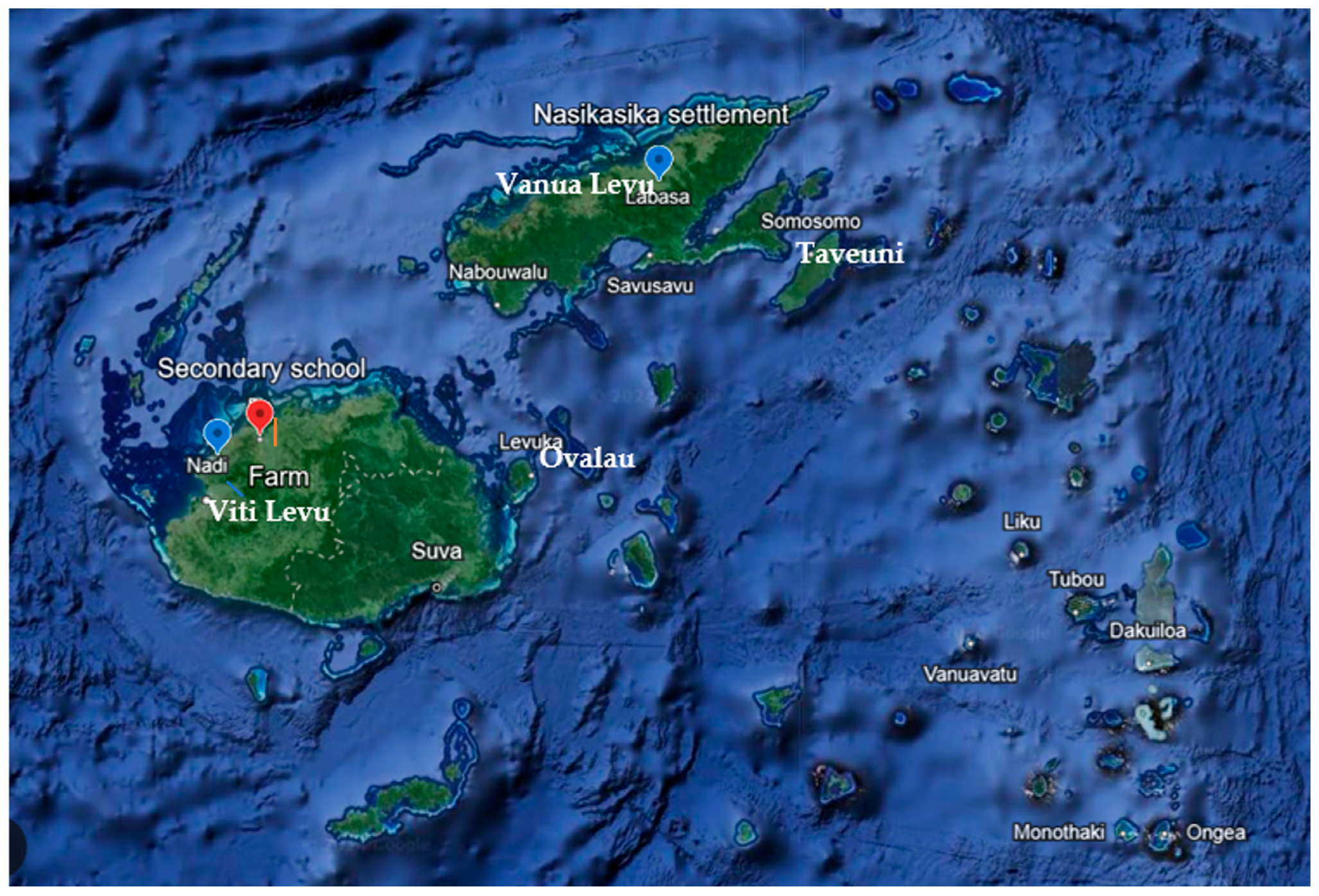
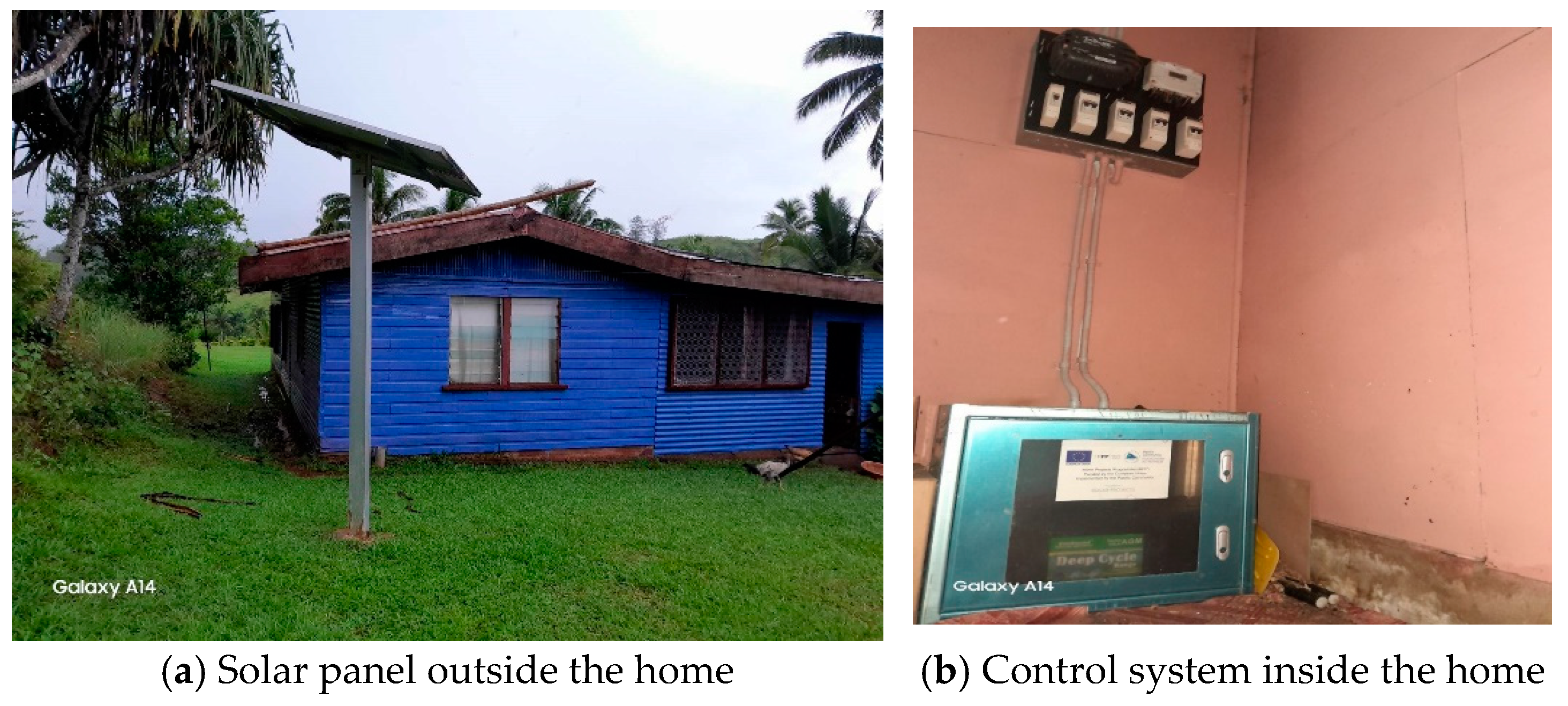
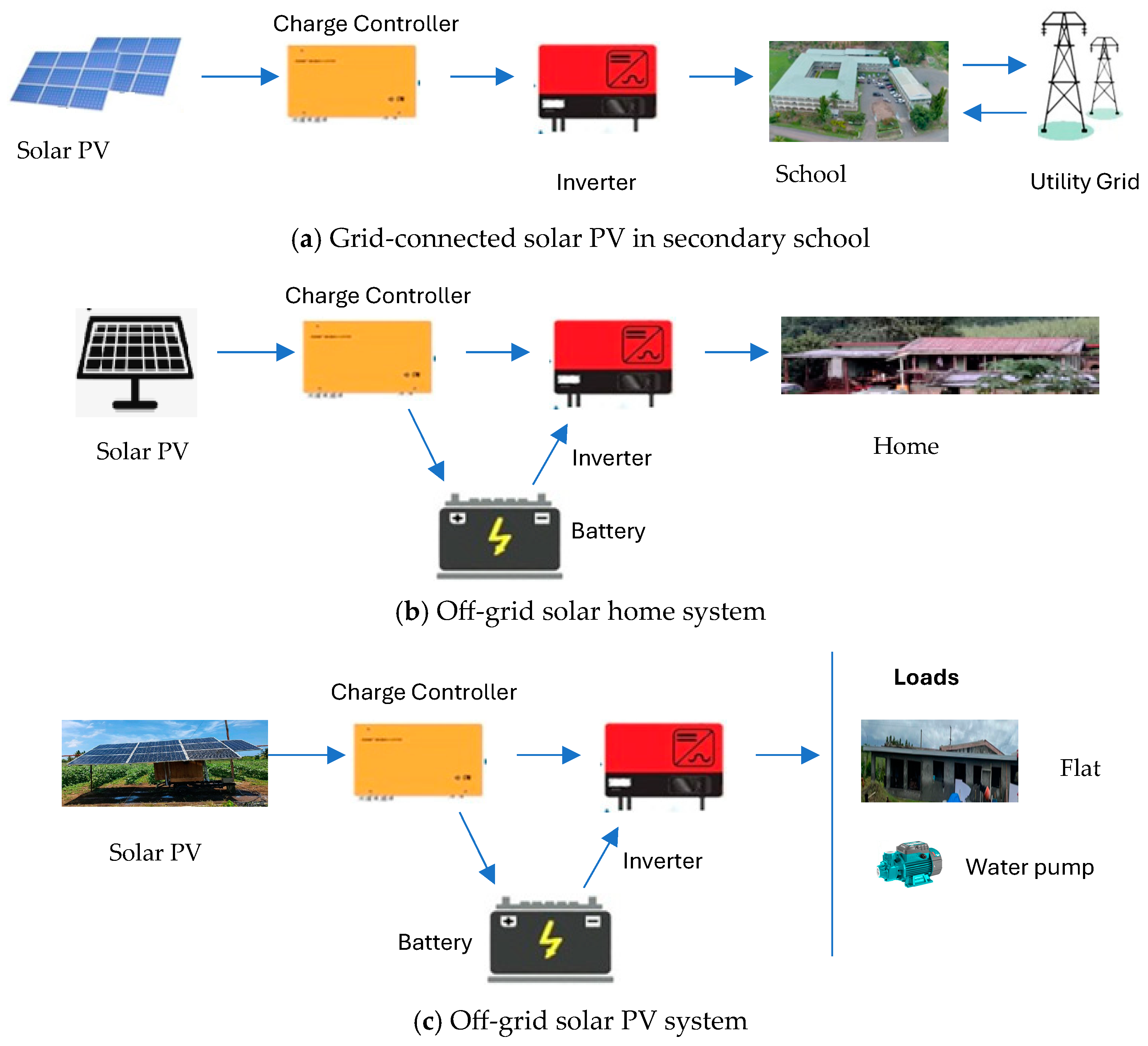

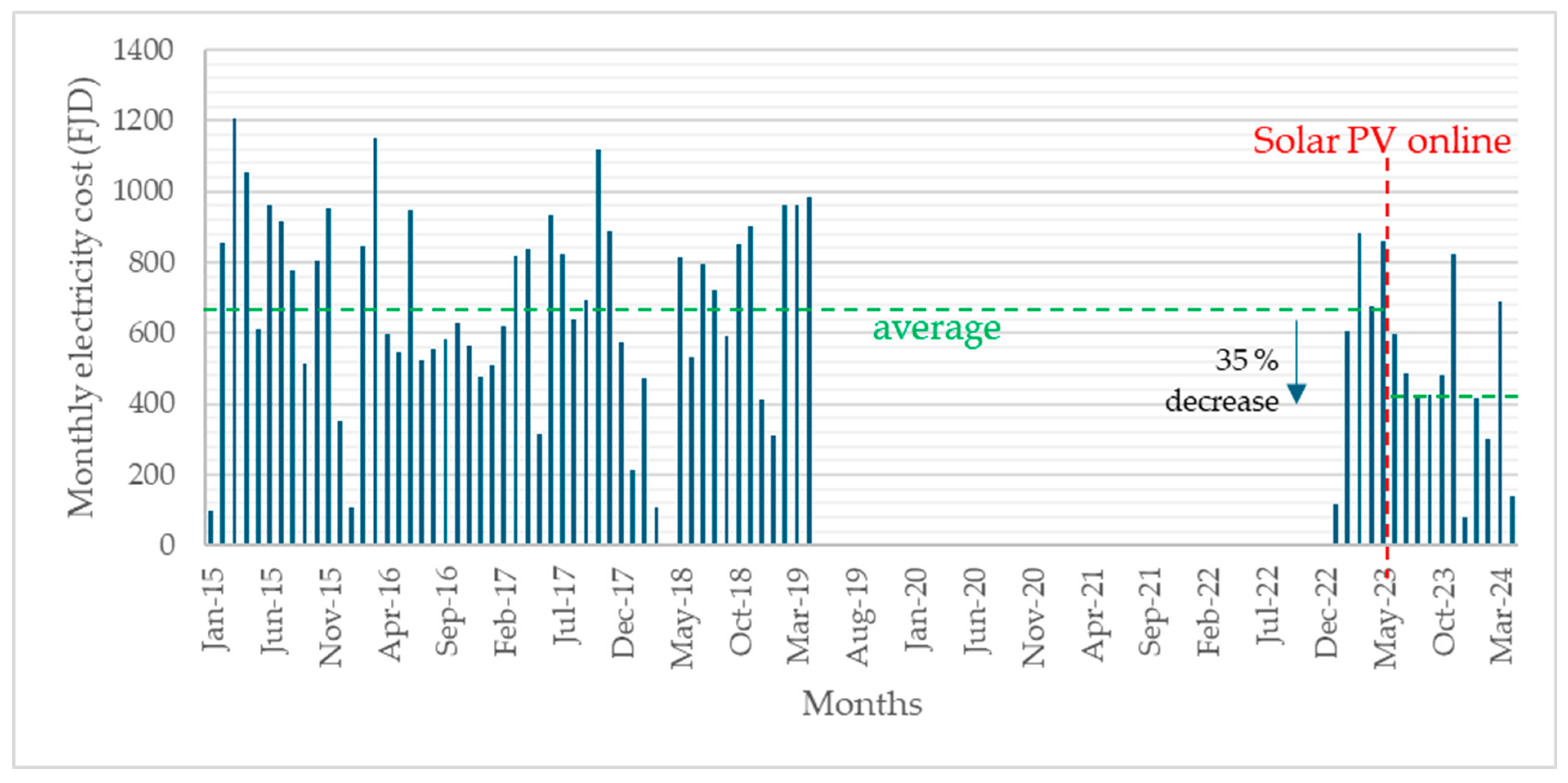

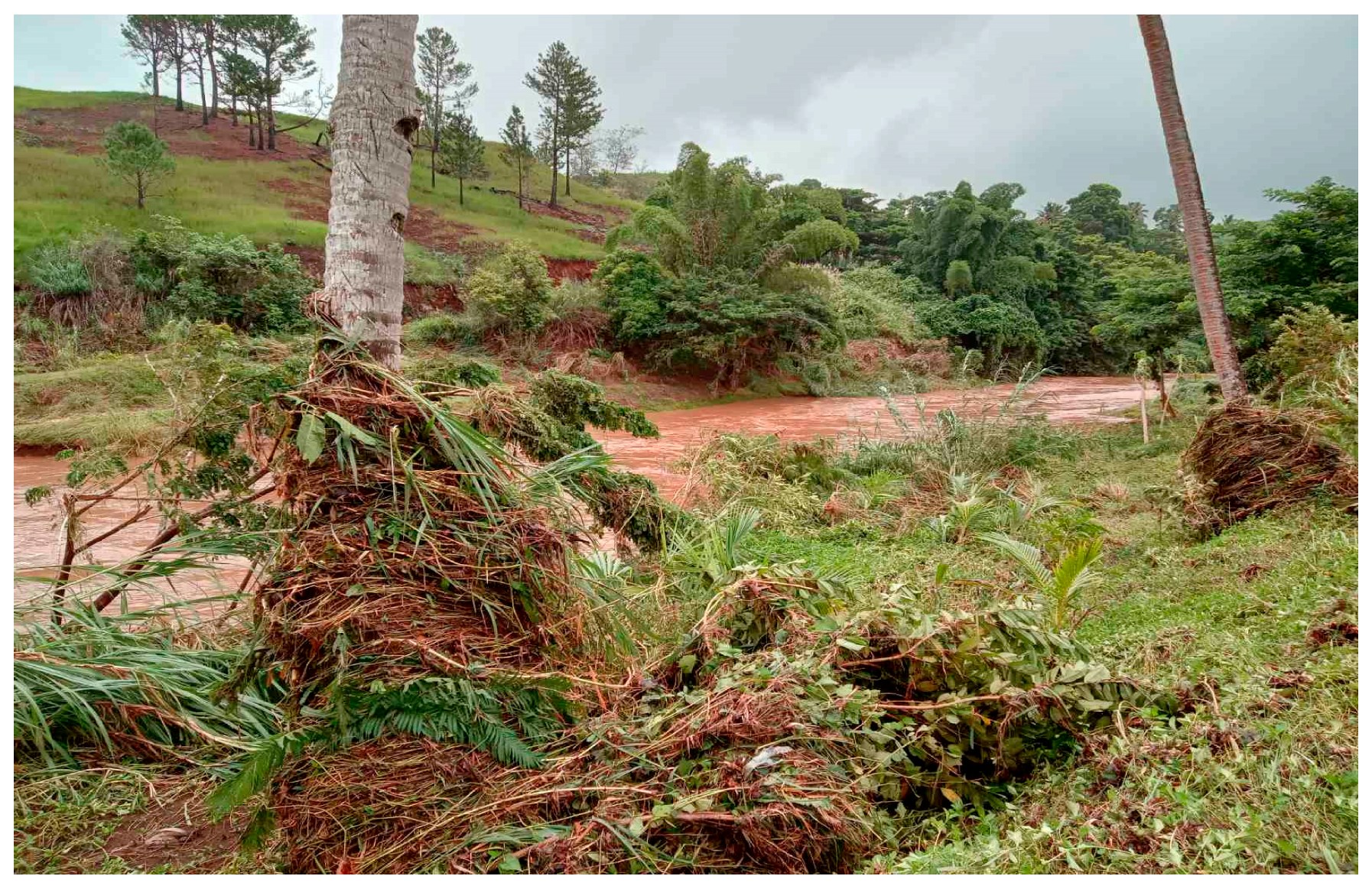
| 25 kW Grid-Connected Solar PV at Secondary School | 0.3 kW SHS at a Rural Settlement (for One Home) | 4.2 kW Off-Grid Solar PV System at a Farm | |||
|---|---|---|---|---|---|
| Parameters | Value | Parameters | Value | Parameters | Value |
| Electricity export rate (USD/kWh) | 0.085 | Electricity export rate (USD/kWh) | 0.17 | Electricity export rate (USD/kWh) | 0.17 |
| Fuel (USD/L) | - | Fuel (USD/L) | 1.50 | Fuel (USD/L) | 1.50 |
| Solar PV | Load characteristics | Load characteristics | |||
| Type | Mono-silicon | Daily AC load (kWh) | Base case and proposed case: 0.6371 | Daily AC load (kWh) | Base case: 4.0 Proposed case: 8.4 |
| Power capacity (kW) | 25.16 | Annual peak load (kW) | 0.13 | Annual peak load (kW) | 4.0 |
| Number of panels | 136 | Inverter for SHS | Inverter | ||
| Efficiency (%) | 14.8 | Capacity (kW) | 0.3 | Capacity (kW) | 4.0 |
| Inverter | Efficiency (%) | 80 | Efficiency (%) | 90 | |
| Capacity (kW) | 25 | ||||
| Efficiency (%) | 90 | Battery for SHS | Battery | ||
| Financials | Days of autonomy | 4 | Days of autonomy | 4 | |
| Cost (USD/kW) | 1500 | Voltage | 12 | Voltage | 48 |
| O&M cost (USD/kW/year) | 39 | Efficiency (%) | 85 | Efficiency (%) | 85 |
| Inflation rate (%) | 3 | Max depth of discharge (%) | 80 | Max depth of discharge (%) | 80 |
| Discount rate (%) | 10 | Charge controller efficiency (%) | 95 | Charge controller efficiency (%) | 95 |
| Project life (years) | 25 | Capacity (Ah) | 200 | Capacity (Ah) | 1101 |
| Emission analysis | Solar PV | Solar PV | |||
| Grid emission factor (tCO2/MWh) | 0.320 | Tracking mode | Fixed | Tracking mode | Fixed |
| Slope | 18 | Slope | 18 | ||
| Type | Mono-silicon | Type | Mono-silicon | ||
| Power capacity (kW) | 0.33 | Power capacity (kW) | 4.185 | ||
| Number of panels | 2 | Number of panels | 9 | ||
| Efficiency (%) | 13.2 | Efficiency (%) | 21.1 | ||
| Initial costs (USD/kW) | 4000 | Initial costs (USD/kW) | 7500 | ||
| O&M costs (USD/kW/year) | 30 | O&M costs (USD/kW/yr) | 30 | ||
| Financial | Financials | ||||
| Inflation rate (%) | 3 | Inflation rate (%) | 3 | ||
| Discount rate (%) | 10 | Discount rate (%) | 10 | ||
| Project life (years) | 25 | Project life (years) | 25 | ||
| 25 kW Solar PV in Secondary School | 0.3 kW Solar Home System at Settlement (One Home) | 4.2 kW Off-Grid Solar PV at the Farm | |
|---|---|---|---|
| Parameter | Values | Values | Values |
| Annual energy output (kWh) | 34,159 | 232 | 3046 |
| Gross annual emissions savings (tCO2) | 10.9 | 0.59 | 10.7 |
| Annual savings (USD) | 2903 | 430 | 1170 |
| No Grant | - | - | - |
| Simple payback (years) | 19.6 | 7.4 | 7.2 |
| Equity payback (years) | >Project lifetime | 6.7 | 6.7 |
| Net present value (USD) | −23,033 | 3232 | 3668 |
| Annual life cycle savings (USD/year) | −2538 | 356 | 404 |
| Benefit–cost ratio | 0.39 | 1.5 | 1.5 |
| GHG reduction cost (USD/tCO2) | 232 | −602 | −210 |
| Energy production cost (USD/kWh) | 0.159 | 2.93 | 0.323 |
| With Grant (USD) | 75,000 | 4000 | 8000 |
| Simple payback (years) | Immediate | 2.5 | Immediate |
| Equity payback (years) | Immediate | 2.4 | Immediate |
| Net present value (USD) | 51,967 | 7232 | 11,668 |
| Annual life cycle | 5725 | 797 | 1285 |
| Benefit–cost ratio | 2.4 | 2.2 | 2.6 |
| GHG reduction cost (USD/tCO2) | −524 | −1347 | −669 |
| Energy production cost (USD/kWh) | 0.00 | 1.03 | 0.036 |
Disclaimer/Publisher’s Note: The statements, opinions and data contained in all publications are solely those of the individual author(s) and contributor(s) and not of MDPI and/or the editor(s). MDPI and/or the editor(s) disclaim responsibility for any injury to people or property resulting from any ideas, methods, instructions or products referred to in the content. |
© 2025 by the authors. Licensee MDPI, Basel, Switzerland. This article is an open access article distributed under the terms and conditions of the Creative Commons Attribution (CC BY) license (https://creativecommons.org/licenses/by/4.0/).
Share and Cite
Prasad, R.D.; Chand, D.A.; Lata, S.S.S.L.; Kumar, R.S. Beyond Energy Access: How Renewable Energy Fosters Resilience in Island Communities. Resources 2025, 14, 20. https://doi.org/10.3390/resources14020020
Prasad RD, Chand DA, Lata SSSL, Kumar RS. Beyond Energy Access: How Renewable Energy Fosters Resilience in Island Communities. Resources. 2025; 14(2):20. https://doi.org/10.3390/resources14020020
Chicago/Turabian StylePrasad, Ravita D., Devesh A. Chand, Semaan S. S. L. Lata, and Rayash S. Kumar. 2025. "Beyond Energy Access: How Renewable Energy Fosters Resilience in Island Communities" Resources 14, no. 2: 20. https://doi.org/10.3390/resources14020020
APA StylePrasad, R. D., Chand, D. A., Lata, S. S. S. L., & Kumar, R. S. (2025). Beyond Energy Access: How Renewable Energy Fosters Resilience in Island Communities. Resources, 14(2), 20. https://doi.org/10.3390/resources14020020







